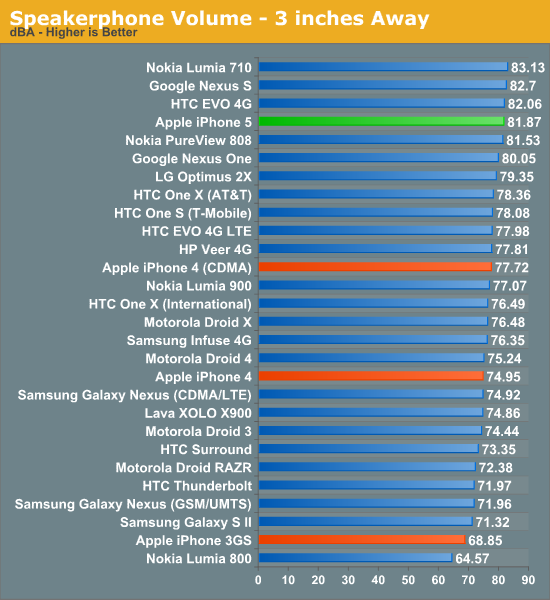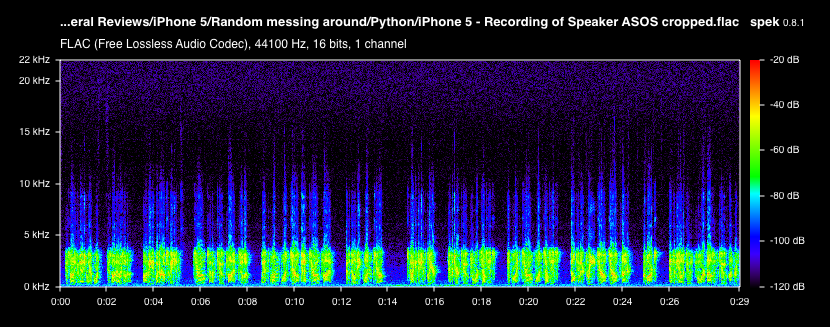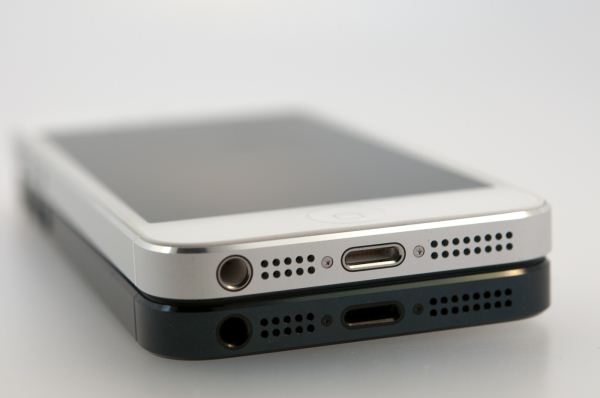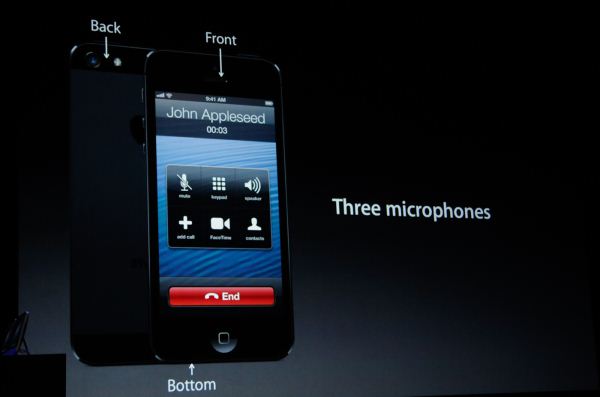The iPhone 5 Review
by Anand Lal Shimpi, Brian Klug & Vivek Gowri on October 16, 2012 11:33 AM EST- Posted in
- Smartphones
- Apple
- Mobile
- iPhone 5
Speakerphone and Noise Suppression
Section by Brian Klug
When Apple changed up the dock connector with the smaller Lightning port, it afforded a chance to also redesign the speakerphone at the bottom of the iPhone 5. Between the iPhone 4 and 4S we saw minimal changes, and performance was acceptable if a bit on the quiet side. With the iPhone 5 Apple advertised a big gain in audio quality with both changes to the speaker and a 5 magnet transducer design.
We normally test speakerphones by calling the local ASOS test number at max volume in front of an Extech sound data logger sampling continually and then averaging over one readout of the weather report. This gives a good feel for the overall loudness of the speakerphone on a call, but doesn’t tell us anything about quality unless you’re standing in front of it. In this case, the iPhone 5 is quite loud and comes in near the top of our scale at 81.8 dBA. It isn’t chart topping but a definite improvement over the relatively quiet 4/4S speakerphone design.

I decided to do something different though after getting a lot of questions and emails asking for a better quality comparison between the iPhone 5 speaker and its predecessor. People are interested in using their smartphones to listen to music when speakers or a dock aren’t available, and I thought this worth investigating. To get to the bottom of this I used my Blue Yeti USB microphone and arm which I use for podcasting to record the speakerphone output at 90 percent volume on the iPhone 4S and iPhone 5.
I started with the test call, which sounds surprisingly different between the iPhone 4S and iPhone 5. The 4S saturates and has obvious distortion even at 90 percent volume. This is quite noticeable in the recording. It then occurred to me that because I’m calling over AT&T (narrowband AMR) and to a PSTN (public switched telephone network) that the call would be limited to 4 kHz thanks to filters along the route, therefore anything above 4 kHz is undesirable. I took a spectral analysis (which shows power spectral density), and instantly it became obvious just how much energy there is on the 4S above the 4kHz limit from overmodulation or saturation/clipping on that speakerphone design. Meanwhile the iPhone 5 has much less energy over that 4 kHz maximum for a PSTN call.
I did the same for two songs recorded start to finish, and the differences are quite noticeable even in my rather quick and dirty recording plus spectogram comparison. I cropped the two recordings of the songs quite a bit and stuck them on soundcloud.

My overall impressions with the iPhone 5 speakerphone is that it has much less of a tendency to clip and saturate than the 4S, all while being noticeably louder. It’s still a smartphone speakerphone but to my ears the difference is pretty dramatic.
Noise Suppression
We’ve known for a while now that Apple changed up the slot for noise cancellation in the iPhone 5. The story goes something like this — Audience was a discrete chip on the iPhone 4, an IP block on the A5 SoC for iPhone 4S, and also an IP block onboard the A6 SoC for iPhone 5. The difference is that with iPhone 5 Audience isn’t enabled, and the company knows this because final characterization with both the final industrial design, microphones, and performance was never performed. Audience claims it met all of its deliverables and targets with the new IP block it built and gave Apple for inclusion on the A6. There’s obviously a lot of speculation about exactly why Apple chose to go with its own soultion versus Audience.
We’ve seen Audience earSmart noise suppression processors in a number of smartphones to date, and carriers often have their own specification for noise suppression to get certified. In addition, with wideband voice (AMR-WB in the case of the iPhone 5) noise suppression is even more important, to say nothing of how big of a topic this is with voice recognition based features like Siri. While we’re on the subject of AMR-WB, this feature is enabled on the iPhone 5 but I’m unable to test it on any of the carriers in the USA at the moment.
Anyhow, the iPhone 5 uses an Apple-specific solution with three total microphones all around the device. One primary microphone at the bottom of the device where you’d expect the primary microphone to reside, a secondary microphone between the LED flash and camera module, and a third right next to the earpiece for use with earpiece active noise cancelation. Apple’s solution is a beamformer (Apple said so in the keynote) and from what I can tell thus works entirely in the time domain. I’ve spent a lot of time playing around with the iPhone 5 trying to characterize its noise rejection, and the system appears to have a number of modes it will kick into after a 5–10 second adaptation time.
Earpiece noise rejection is something I talked about on the podcast right after the iPhone 5 hands on, and is one of those modes that the iPhone 5 will kick into if you’re in a loud environment. It isn’t active all the time, but when it does transition into working it provides a noticeable suppression of ambient noise and the same kind of pressure I’ve felt with other active noise canceling closed ear headphones. The improvement isn’t overwhelming, but it’s a sensation and feature I haven’t experienced on any other smartphones to date.
The rest of the noise suppression story is really one of testing. To test, I ran our normal test suite which consists of me ramping ambient music to 94 dBA while speaking into the device under test and recording the other side of the call. I’ve gotten ahold of the industry standard babble and distractor tracks used by carriers for testing noise suppression and will move to those in the future, for now though the test track I currently play is something I understand pretty well.
The comparison here is between the iPhone 4S and iPhone 5 to see just how ambient noise suppression has changed with this change in solution. The difference in technique is pretty apparent, and again indicates to me that the iPhone 5 is working in the time domain. You can see visible cut in and cut out on the waveform. The Audience solution has some hiss that develops at the absolute highest background noise volume on the 4S, but it also does an excellent job suppressing noise. The Apple solution doesn’t have this hiss, but passes both background noise and vocals from the music passed through the call at maximum volume. I hate to call this a regression, but the difference in technique means that there’s audible background noise that gets passed on while I’m talking on the iPhone 5. I think for normal callers the difference won’t be readily apparent, but with close inspection it is dramatic.













276 Comments
View All Comments
mykebrian - Thursday, October 18, 2012 - link
is motorola razr i same price with iphone 5?Death666Angel - Thursday, October 18, 2012 - link
"By controlling its own SoC destiny it could achieve a level of vertical integration that no OEM has enjoyed in recent history."I would argue that Samsung enjoys a similar level of vertical integration. They trade the OS-stuff for some fabs. Not sure which can be more profitable. But other than that, they are very much like Apple in terms of vertical smartphone integration I think. :)
iwod - Thursday, October 18, 2012 - link
Any Reason Why Front Camera not using High Profile When Recording Video? It could have saved yet another bit of space with MUCH better quality then baseline.And do Apple offically support play back of H.264 High Profile Video Clip yet?
Spunjji - Friday, October 19, 2012 - link
I very much appreciated the details on the SoC design. Your attempts to refine your battery life analysis were also appreciated, as these do seem to better reflect real-world usage. In general this article was well-researched, well-written and very informative.Unfortunately, the section on the anodization process does end up reading like one big apology. The matter is explained in detail but it's done with an air of resignation, as if this were the only option available to Apple. The fact is that they could have retained some additional girth (whilst still losing some) and had a device with good handling, good aesthetics and superior durability. No comparison to competing devices is made whatsoever, so we have no idea based on your article alone if this really is unavoidable or just poor choice of materials.
The same goes for the part about the camera flare. Is a short comparison with a few relevant models too much to ask? The problem is that (like the previous criticism) I already know how this comes out and it doesn't look very good for Apple.
So there are hundreds of hours spent testing comparative performance and battery life where Apple win, yet no time at all dedicated to comparative analysis where they do not look so good. That starts to look upsettingly like bias. I hope that isn't the case but based on other areas (notebook reviews in particular) it starts to feel like a theme.
Anandtech, as a site I love your tech journalism, but the personal preferences of the writers need to stay at home (or firmly in editorials).
Slaanesh - Friday, October 19, 2012 - link
Couldn't agree more.Krysto - Friday, October 19, 2012 - link
I have to agree. Through out the article, you almost got the impression of worship from the writers, and they've only focused on what Apple did right and how much better that was than their competitors.And what's with all the going back to history of Apple's devices? Was that really necessary for a phone review? Should we expect this for all new iPhones...or for all new Galaxy S devices? I think that part alone shows bias.
And was 50 page review (or whatever it is) really necessary and to wait a month and a half after the product launch? The reason I'm asking is because I know they will never repeat this for any other non-Apple product. But I also think it's kind of pointless, and reviews need to appear max 1 week after the product launches. Maybe two. More than that is really pointless, and it's already obvious in the review that half of it is about how awesome Apple were in the past and still are, and only the other half goes down to the analysis.
dyc4ha - Saturday, October 20, 2012 - link
+1Klugfan - Friday, October 19, 2012 - link
Does everyone remember Edward Tufte's complaints about the iPhone 4 design?If I wasn't concerned about impact on the antenna performance, I'd be tempted to take some fine grit sandpaper to my black iPhone 5, and round off the edges a little. Believe it.
If your biggest concern about phones _really_ is resale value, well the iPhone 5 will do fine, with or without scuffs. If your biggest concern about brain phones is what they look like to other people who see you using them, well, first you're an idiot, and second the iPhone 5 really will do fine there, with or without scuffs.
Does my phone make me look smug? Whatever shall I do.
Hxx - Friday, October 19, 2012 - link
got this phone close to release day and I'm throughly impressed with it. Coming from a droid incredible 2 who crapped out on me 10 months after purchase (the memory slot broke and lost all my pics, videos etc - not fun) I gotta say this is my first interaction with an iOS powered device and so far i love it. I think most Apple products are overpriced (hence the reason why i never got one) but this phone is a beauty for $199 given that i paid almost just as much 1 year ago for my droid phone. A huge thank you to Anandtech for providing such detailed review. Although i may never need as much detail about a phone :-), its nice to know i can always rely on you guys if I ever have any technical questions.Good job Guys!
ol1bit - Friday, October 19, 2012 - link
As always, Anandtech gets into the details I didn't even know I wanted to read about!I'm not an apple product owner, and never plan to be, but it really appears to be a great phone.
Keep up the good work!